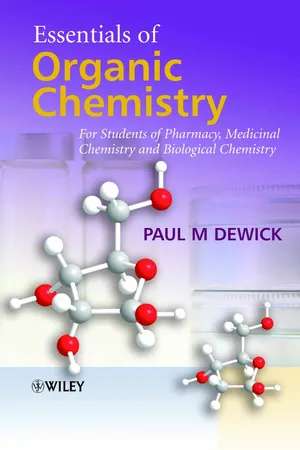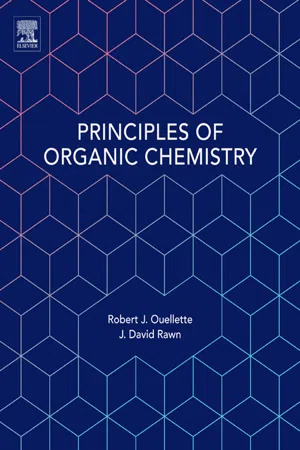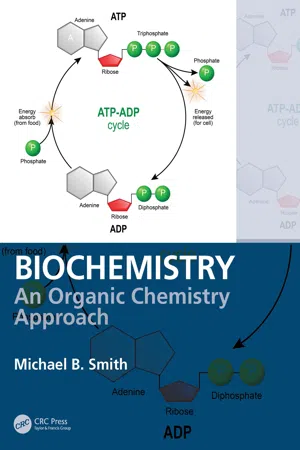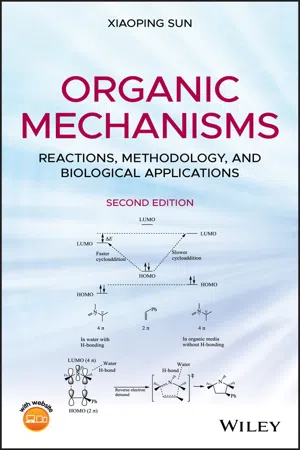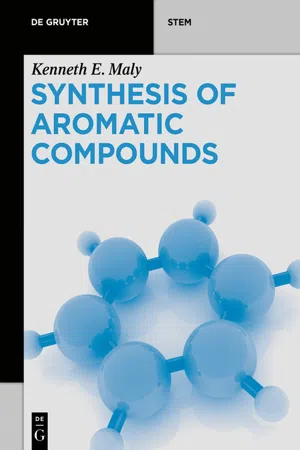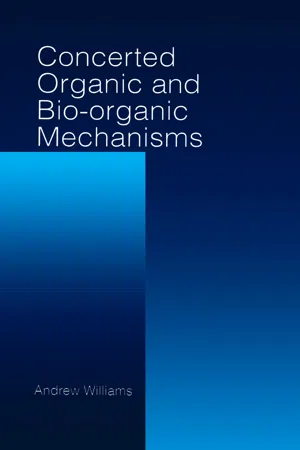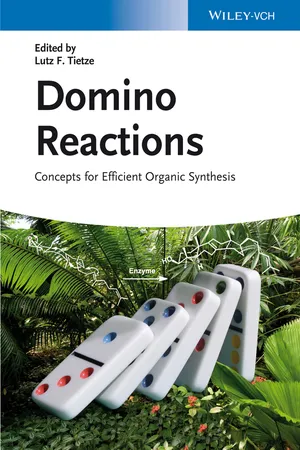Chemistry
SNi Reaction
The SNi reaction is a type of nucleophilic substitution reaction in organic chemistry. It involves a two-step process where the leaving group departs before the nucleophile attacks the substrate. This reaction mechanism is characterized by a hybrid of SN1 and SN2 characteristics, and it often occurs in reactions involving polar aprotic solvents and hindered substrates.
Written by Perlego with AI-assistance
Related key terms
Related key terms
1 of 4
Related key terms
1 of 3
7 Key excerpts on "SNi Reaction"
- eBook - ePub
Essentials of Organic Chemistry
For Students of Pharmacy, Medicinal Chemistry and Biological Chemistry
- Paul M. Dewick(Author)
- 2013(Publication Date)
- Wiley(Publisher)
6
Nucleophilic reactions: nucleophilic substitution
As the term suggests, a substitution reaction is one in which one group is substituted for another. For nucleophilic substitution, the reagent is a suitable nucleophile and it displaces a leaving group. As we study the reactions further, we shall see that mechanistically related competing reactions, eliminations and rearrangements, also need to be considered.6.1 The SN 2 reaction: bimolecular nucleophilic substitution
The abbreviation SN 2 conveys the information ‘substitution–nucleophilic–bimolecular’. The reaction is essentially the displacement of one group, a leaving group, by another group, a nucleophile. It is a bimolecular reaction, since kinetic data indicate that two species are involved in the rate-determining step:where Nu is the nucleophile, RL the substrate containing the leaving group L, and k is the rate constant.In general terms, the reaction can be represented as belowDifferences in electronegativities (see Section 2.7) between carbon and the leaving group atom lead to bond polarity. This confers a partial positive charge on the carbon and facilitates attack of the nucleophile. As the nucleophile electrons are used to make a new bond to the carbon, electrons must be transferred away to a suitable acceptor in order to maintain carbon’s octet. The suitable acceptor is the electronegative leaving group.The nucleophile attacks from the side opposite the leaving group – electrostatic repulsion prevents attack in the region of the leaving group. This results in an inversion process for the other groups on the carbon centre under attack, rather like an umbrella turning inside out in a violent gust of wind. The process is concerted, i.e. the bond to the incoming nucleophile is made at the same time as the bond to the leaving group is being broken. As a consequence, the mechanism involves a high-energy transition state in which both nucleophile and leaving group are partially bonded, the Nu–C–L bonding is linear, and the three groups X, Y, and Z around carbon are in a planar array. This is the natural arrangement to minimize steric interactions if we wish to position five groups around an atom, and will involve three sp 2 orbitals and a p orbital as shown. The p orbital is used for the partial bonding; note that we cannot have five full bonds to a carbon atom. The energy profile for the reaction (Figure 6.1 - eBook - ePub
- Robert J. Ouellette, J. David Rawn(Authors)
- 2015(Publication Date)
- Elsevier(Publisher)
N 2 reaction.When (R) -2-bromobutane reacts with sodium hydroxide, the substitution product is (R) -2-butanol. The reaction occurs with inversion of configuration. Thus, the nucleophile approaches the electrophilic carbon atom from the back and the leaving group simultaneously departs from the front of the substrate in the SN 2 mechanism.The SN 1 Mechanism
A nucleophilic substitution reaction that occurs by an SN 1 mechanism proceeds in two steps. In the first step, the bond between the carbon atom and the leaving group breaks to produce a carbocation and, most commonly, an anionic leaving group. In the second step, the carbocation reacts with the nucleophile to form the substitution product.The formation of a carbocation is the slow, or rate-determining, step. The subsequent step, formation of a bond between the nucleophile and the carbocation, occurs very rapidly. Because the slow step of the reaction involves only the substrate, the reaction is unimolecular. Because only the substrate is present in the transition state, the rate of the reaction depends only on its concentration, and not on the concentration of the nucleophile.Figure 7.3 shows an energy diagram tracing the progress of a reaction that occurs by an SN 1 mechanism. The rate of the reaction reflects the activation energy required to form the carbocation intermediate. The activation energy required for step 2, addition of the nucleophile to the carbocation, is much smaller, so step 2 is very fast. The rate of step 2 has no effect on the overall rate of the reaction.Figure 7.3 Activation Energy and the SN 1 ReactionThe reaction of 2-bromo-2-methylpropane occurs in two steps with formation of an intermediate carbocation. It forms in the rate-determining step, which does not involve the nucleophile. In the second, fast step, the carbocation reacts with a nucleophile such as water to form the product. - eBook - ePub
Biochemistry
An Organic Chemistry Approach
- Michael B. Smith(Author)
- 2020(Publication Date)
- CRC Press(Publisher)
N 1 reactions and then describe nucleophiles that are common in biochemical applications and the substitution reactions that are common for these nucleophiles. Nucleophilic reactions require electrophilic species. Electrophiles or electrophilic substrates are common in biochemistry, including phosphonate derivatives, carbonyl compounds and imine compounds. Any discussion of typical nucleophilic reactions also requires an understanding of such electrophilic substrates. The fundamentals of both acyl addition and of acyl substitution reactions will be presented for carbonyl electrophilic centers and the reactions of these electrophilic centers with nucleophiles.3.1 Nucleophiles and Bimolecular Substitution (the SN 2 Reaction)The SN 2 reaction is one of the seminal reactions in a typical undergraduate organic chemistry course. The reaction of 1-bromo-3-methylbutane with sodium iodide (NaI) using acetone as a solvent gave 1-iodo-3-methylbutane, in 66% yield.1 In terms of the structural changes, the iodide ion substitutes for the bromine, producing bromide ion (Br– ). Iodide reacted as a nucleophile in the reaction at Cδ+ of the alkyl bromide, breaking the C—Br bond and transferring the electrons in that bond to bromine. In molecules that contain the C—Br bond, or indeed a C—C bond, where X is a heteroatom-containing group, the carbon will have a δ+ dipole. In other words, the carbon atom is electrophilic, and the substrate that reacts with the nucleophile is called an electrophile. The reaction of a nucleophile with an aliphatic electrophile is formally called nucleophilic aliphatic substitution , illustrated in Figure 3.1 . The displaced atom or group (e.g., chloride), departs (leaves) to become an independent ion. Displacement of chlorine leads to the chloride ion (Cl– ), but the bromide ion, iodide ion, or a sulfonate anion also correlates to X, which is referred to as a leaving group . In many biochemical reactions, the leaving group is a phosphate, —O–PO2 –O—.1 Furniss, B.S.; Hannaford, A.J.; Smith, P.W.G.; Tatchell, A.R. (eds.), Vogel’s Textbook of Practical Organic Chemistry , 5th ed. Longman, Essex, UK, 1994 , Exp. 5.62, p. 572.FIGURE 3.1 Nucleophilic attack at a sp3 carbon bearing a leaving group.A leaving group does not spontaneously “fly off” or “leave,” it is displaced by the nucleophile after collision with the electrophilic carbon atom. In other words, the incoming nucleophile effectively “kicks out” the leaving group, but only after collision with the electropositive carbon. The rate of the SN 2 reaction (the speed at which the reactants are converted into products) is proportional to the concentration of both the nucleophile and the electrophilic substrate. The rate at which this reaction occurs is proportional to the concentration of the nucleophile and also the concentration of the alkyl halide, and this type of rate expression is second-order . To change the proportionality to an equality, the expression must contain a proportionality constant, k - eBook - ePub
Organic Mechanisms
Reactions, Methodology, and Biological Applications
- Xiaoping Sun(Author)
- 2020(Publication Date)
- Wiley(Publisher)
This steric hindrance (characteristic of a tertiary‐butyl group or any tertiary substrate) makes an S N 2 reaction extremely slow (Fig. 6.5). On the other hand, because a tertiary carbocation, such as (CH 3) 3 C +, is relatively stabilized, an S N 1 reaction for a tertiary substrate can take place in a relatively fast rate (Fig. 6.17). In general, the nucleophilic substitution reaction of a tertiary (3°) substrate always follows the S N 1 mechanism. The reaction can be effected by a weak nucleophile (mostly neutral molecules). The type of solvents can change the reaction rate, but does not change the mechanism. For a secondary (2°) substrate such as 2‐halopropane (CH 3) 2 CHX, as the number of methyl groups on the central electrophilic carbon increases, the steric hindrance to the nucleophilic attack from the opposite side of the leaving group is getting more severe. This disfavors an S N 2 reaction, but does not completely prevent it from happening (Fig. 6.5). On the other hand, the stability of a secondary (2°) carbocation allows the S N 1 reaction of a 2° substrate to take place in an appreciable rate (see Fig. 6.17). In addition, a primary substrate which contains an unsaturated group (such as phenyl and vinyl) on the electrophilic carbon can also have both S N 1 and S N 2 reactions. In general, the nucleophilic substitution reactions of a secondary (2°) substrate and a primary (1°) benzylic or allylic substrate can follow either the S N 2 or S N 1 mechanism, depending on the nature of the nucleophile and solvent. Usually, when a reaction is performed with a strong nucleophile (mostly, an anion) in an aprotic solvent, it follows the S N 2 mechanism. If a reaction is performed with a weak nucleophile (mostly, a neutral molecule) in a protic solvent, it follows the S N 1 mechanism. Now, let us look at nucleophilic substitution reactions of (R)‐2‐bromobutane, a secondary haloalkane, performed in different conditions (Fig - eBook - ePub
- Kenneth E. Maly(Author)
- 2022(Publication Date)
- De Gruyter(Publisher)
3 Nucleophilic aromatic substitution reactions3.1 Introduction
In the previous chapter, we saw that aromatic rings themselves are usually nucleophiles, reacting with electrophiles in electrophilic aromatic substitution reactions. Furthermore, SN 2 reactions cannot take place at the sp2 hybridized carbon atoms of an aromatic ring. Nonetheless, as we will see in this chapter, nucleophilic displacements on aromatic rings can occur. We will explore the mechanistic scenarios for nucleophilic aromatic substitution with particular attention to the addition–elimination mechanism. We will also consider the chemistry of aryl diazonium salts, which bear superficial resemblance to nucleophilic aromatic substitution.3.2 Addition–elimination of nucleophiles (SN Ar)
The most common type of nucleophilic aromatic substitution at an aromatic ring proceeds first by nucleophilic addition to the carbon bearing the leaving group to form a delocalized carbanion intermediate, followed by expulsion of the leaving group and rearomatization [1 ]. Because the reaction proceeds by an anionic intermediate, it usually involves electron-deficient aromatic rings. The rate-determining step is typically nucleophilic addition and the reaction usually requires electron withdrawing groups ortho or para to the site of nucleophilic attack (Figure 3.1 ).Figure 3.1: Generalized SN Ar mechanism.As shown in Figure 3.1 , initial nucleophilic attack at the carbon bearing the leaving group results in a delocalized carbanion intermediate, referred to as a Meisenheimer complex. The reaction often requires electron-withdrawing groups ortho or para to the leaving group in order to stabilize the negative charge of the intermediate. The most common electron-withdrawing groups used to activate compounds toward nucleophilic aromatic substitution are nitro groups, but other frequently used groups include cyano, carbonyl, and sulfonate groups. All of these groups can stabilize the negative charge by resonance. This direct resonance stabilization explains the importance of having electron-withdrawing at the ortho- and/or para-positions – groups in the meta-positions can only stabilize the negative charge inductively. As strong support for this mechanism, several Meisenheimer intermediates have been isolated and characterized (Figure 3.2 ) [2 - eBook - ePub
- Andrew Williams(Author)
- 2020(Publication Date)
- CRC Press(Publisher)
Chapter 5Nucleophilic Displacements at Saturated Carbon
The classical reaction involving nucleophilic displacement at aliphatic carbon has been a test-bed of mechanistic theories since they were first studied almost a century ago. The perceived mechanism for this reaction developed in step with the development of mechanistic ideas. Ingold and Hughes described two main mechanisms, namely the concerted SN 2 (AN DN ) process and the stepwise SN 1 (DN +AN ) process, but both pathways have now been subjected to considerable study to the extent that at one time the validity of the concerted SN 2 path was in serious doubt.1The points which have arisen for nucleophilic substitution at saturated carbon are mainly due to experimental data from the following types of study: (i) stereochemistry which gives data consistent with but does not require a concerted mechanism; (ii) determination of the lifetimes of carbenium ion intermediates has enabled predictions to be made regarding enforced concertedness; (iii) isotope effects have enabled the strengths of bonds to be determined in the transition state structures; (iv) positional isotope exchange has given information regarding the stability of ion-pair intermediates; (v) gas phase and theoretical studies have yielded information about the potential energy surfaces to be expected in nucleophilic substitution at saturated carbon.5.1 MECHANISMS
The More O’Ferrall-Jencks diagram (Figure 5.1 ) provides a means for discussing the relationships between the mechanisms for nucleophilic aliphatic substitution1 , 2 , 3already delineated by Ingold. The diagram indicates that, for the purposes of providing a surface, the 0,1 position corresponds to a hypothetical pentacoordinate intermediate;2 ,4it is feasible to conceive of such a structure as a station on the surface although the corresponding molecule has only been isolated in exceptional circumstances. There is no inconsistency in postulating such a hypothetical structure for a corner when it is considered that all non-corner structures on the surface are themselves hypothetical. There has been discussion of the existence of such a pentacoordinate intermediate; hypervalent anionic carbon structures are well characterised in organometallic chemistry5 , 6 , 7 , 8 , 9 , 10 , 11 , 12 , 13 , 14 , 15 , 16and the intermediate constitutes part of the E2C mechanism of elimination.9 A hypervalent molecule directly analogous to the structure of the (0,1) corner has been stabilised by the use of special structural constraints and isolated (5.1, Scheme 5.1). The structure was shown to be neither 5.2 nor a rapidly interconverting equilibrium mixture (5.3).17 , 18 , 19 , 20 , 21 - eBook - ePub
Domino Reactions
Concepts for Efficient Organic Synthesis
- Lutz F. Tietze(Author)
- 2013(Publication Date)
- Wiley-VCH(Publisher)
N 1 reaction) [1b]. The primary step in this process is the attack of a nucleophilic species, either an anion (e.g., a carbanion, an enolate, alkoxide, or thiolate) or a “pseudo” anion, as an uncharged nucleophile (e.g., an amine or an alcohol) on to an electrophilic center bearing a leaving group. A bond formation takes place with the creation of a new “real” or “pseudo-anionic” functionality, which can undergo further transformations, by being trapped by an electrophilic center present in the molecule (conjugated enone, aldehyde, epoxide, etc.). The sequence can then be terminated either by the addition of a proton or by the elimination of an X group.In the first part of the chapter, we have covered mostly those reactions, initiated by SN 2 type nucleophilic substitution, followed by a Michael reaction on a α,β-unsaturated ketone moiety, present in the intermediate adduct (SN /Michael). A few examples of the reactions with carbonyl compounds and alkyl halides (twofold SN reactions) in the second step are also included.The large numbers of domino reactions, which are initiated by nucleophilic substitution, are those, involving nucleophilic ring opening of three membered rings, for example, epoxides, aziridines, and a few activated cyclopropanes. These strained three membered compounds undergo facile ring opening by various nucleophiles, resulting in the generation of another nucleophilic species (e.g., alkoxide or amine), which can react further inter- or intramolecularly, undergoing a variety of reactions, including transition metal catalyzed cross-coupling reactions. In this context, it should be noted that it is of no relevance, whether the process involves a nucleophilic or electrophilic ring opening of an epoxide or aziridine and whether a carbocationic intermediate is of formal or real nature. Thus, the second part of the chapter deals with those domino reactions involving nucleophilic ring opening of epoxides, aziridines, and cyclopropyl ketones as the first step.The third section of the chapter describes recently developed “anion relay chemistry” (ARC) involving threefold domino SN -Brook rearrangement/SN
Index pages curate the most relevant extracts from our library of academic textbooks. They’ve been created using an in-house natural language model (NLM), each adding context and meaning to key research topics.
Explore more topic indexes
Explore more topic indexes
1 of 6
Explore more topic indexes
1 of 4
